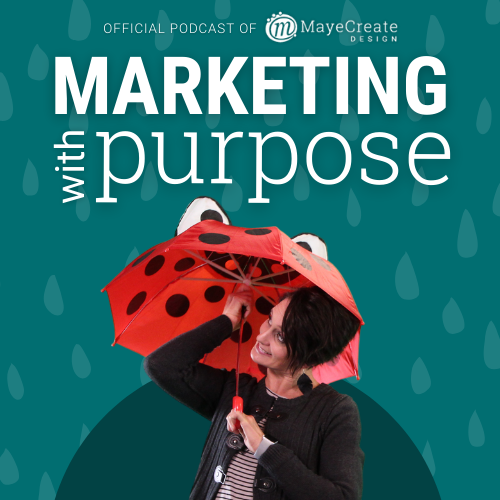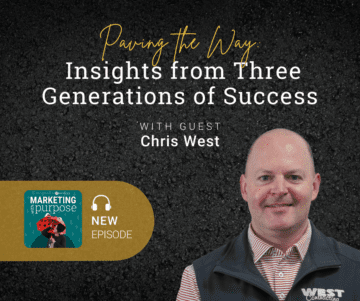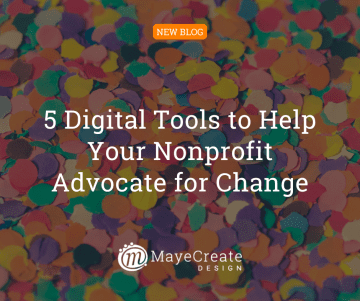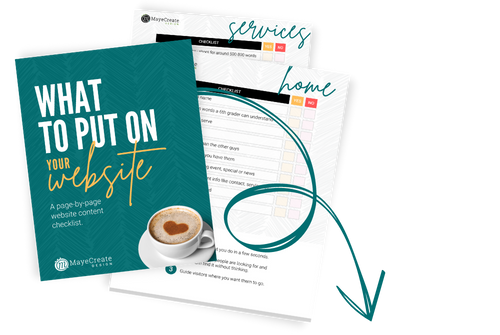Time Saving Tips – Zero to Marketing Super Hero – Part 3
January 15, 2021
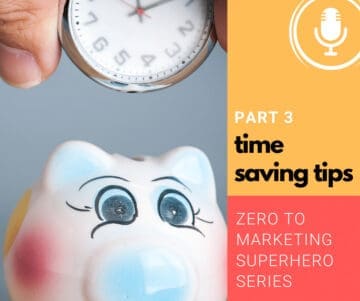
CONSUME CREATIVELY
This content is available in:
This content is available in:
AUDIO
TEXT
My team and I have been rolling out marketing for the last 15 years. Take an inside look at how we develop processes at MayeCreate that help us get our work done. And then because I LOVE tools I geek out so hard explaining my favorite time saving low tech tools, design tools, and medium tech tools that you can use to supercharge your marketing efforts and get more stuff done in less time.
Today I’m going to share with you the third part of our Zero to Marketing Superhero series, which is: Time-Saving Tips.
To be a real marketing superhero, you have to do two things – just two. You don’t have to have an MBA or a PhD in marketing, you don’t have to have billions of years of experience. You just have to:
1. Get the work done, and…
2. Make sure that it worked
We’ve been talking in the past couple posts in the series about how getting started in your marketing is really about just getting started – Doing the things that need to be done. They’re not going to be perfect to begin with, you start where you are.
But I don’t have the time!
Maybe you’re thinking, “Wait a second, Monica, I didn’t really even have time to do my job. How am I going to get more stuff done? How am I going to get all this marketing stuff done?”
That’s where this article is going to come in really handy, because my team and I have been rolling out marketing for the last 15 years. And we work really hard on being efficient.
We actually have a member of our team – Stacy – who is ridiculous. She’s always like “our everything must be more efficient”. She’s always looking for that next little tweak, and we really integrated that mindset into the culture of our company. We’re always asking, how do we become more efficient? How do we get the work done, but still at that same quality? You want great stuff, but how do we do it more efficiently?
So, I’m going to share with you the way that we develop processes that help us get our work done. And I’m also going to share with you tools – low-tech tools, design tools, and medium-tech tools – that you can use to supercharge your marketing efforts and get more stuff done in less time. So that way you can get back to doing what’s most important for your organization, which is serving your mission.
Onward to the time-saving tips!
The first tip that I’m gonna give you, you’re not gonna like. You just want me to give you tools. I know this because I am the same way. I love a good tool, because it makes my work so much easier.
But here’s the deal:
There is no band-aid for process. There is no skinny pill for process. Process. Makes. Perfect.
Tweet
It’s just like everything else in your organization: The things that you do regularly, the things that have systems to support them, those are the things that you do really, really well.
The things that are out of process – Those are harder, they take more time, they take more thought. And they often have hiccups in them and don’t go as well, because you couldn’t foresee all the challenges that you might face within your work.
So really, the next piece of getting your head on straight so you can be a marketing superhero is documenting and embracing a process for your marketing. Because like I just said, when it comes to marketing…your process, it makes perfect. You have to get the work done. And then you have to make sure that it worked. But that process is the system that’s going to allow you to get the work done.
Just setting a goal isn’t enough, you actually need to have a system to get there. Because you know you don’t just sit there and say, “Well, I want to run a marathon this year”, and then you never run until you get to the starting line! If that’s what you did, you couldn’t actually expect to finish the thing, right?
That system does not work.
This is not coming from a full marathoner, but a regular half marathoner – That system does not work, and it doesn’t work in your marketing either.
Even on the simplest things – Let’s say that you’re just designing a little postcard or you’re gonna design a graphic for your social media. If you don’t think through the elements that need to go on that graphic, if you don’t think about what size it is and what day you need it by, then you could design it without something important and then have to go in and revise it. You could design it the wrong size, have to revise it, then you could start too late and not have it done on time.
All of these things will take you more time than taking a step back to begin with, and thinking through the process of how you’re going to get all the information out and ready to do your marketing.
How to create an efficient marketing process
The way that we go about creating great marketing processes (to get things done right the first time), is we:
- Have a brainstorming session to figure out what needs to be done
- Break the project into milestones to signify each stage of development
- Make a set of tasks to guide people through each milestone and explain the outcomes of those tasks
- Determine who’s going to do each task
- Record how you’re going to measure the success to know that it’s working
- Document your process
I’m a big picture person – I go through the milestones pretty quickly, and can figure out the stuff that needs to be done. But I usually need some help to get all those tasks to guide people through each milestone. Until I’m actually doing it, I don’t think about what each one of those little tasks are or need.
You can then explain the outcomes of each of your tasks, and then determine who on your team has the talents that are best suited for each task. You don’t have to do all this stuff, you can hand it off to somebody else!
And then, of course, you would record how you’re going to measure your success and know that it’s working. Measuring success could be recording how much time it took you to do the task, or it could just be, did people like it? Did they comment? Did they share? Did they open the email?
Then you need to document your process – You can put it in a spreadsheet, you can make a bulleted list in a Google Doc, or you can put it in a project management software. But regardless of where you decide to house it, you need to make sure it’s some place that everybody can get to it. And that’s one of my low-tech tools is everything Google, and I’ll explain more about how we use it in a second.
You don’t always have to reinvent the wheel
For those of you who actually, really do want to make your marketing easier, believe me that a process is the thing that’s going to do it. Because it is my friends, it is. Take it from the woman who likes to do something different every single time that she does it. Man, it is not efficient, right?
Heck, I just spent 10 minutes before I recorded the podcast for this blog post, because I really hated the fact that the spacebar is play, but it’s not also pause. I wondered if I can change that in my program, because it would save me so much time from going back and forth and finding the audio where I just wanted to edit.
And by golly, you can’t actually change that. No, you can’t. But I just spent the time doing it. And it’s just because I’m always looking to make that process better. But I also tend to do things maybe slightly differently every time which is why I have to make a process and follow it, because I’m too creative for my own good.
I have some examples of this “process-creation process” in my Nonprofit Marketing Plan Template. You can look through some examples in there from a social media perspective or print design perspective, things that you’re likely doing in your organization and see what works for us.
Have a Plan B
After you get your process relatively roughed out, consider what happens when things don’t go right. People often overlook this part, and then your whole system is gonna fall apart.
For example – What happens when the boss decides that they’re way too busy to review the marketing, and they just don’t do it. You know if they don’t review it then you’re not going to get it done on time, and you know that it needs to be done. And if you’re not empowered to make a decision, then they won’t have it when they need it.
So are they going to hold you accountable for the mistakes that they missed by not reviewing the work?
This is a conversation that we have with all of our retainer clients, especially those that we provide social media, online ad management, or other content for. They know if they don’t review the items, then we’re going to send them on time and we’re going to publish them anyway. Because we’re not going to let them get away with hindering their own success by not being committed to the outcomes of their projects.
Get your boss on board for the same thing, because some bosses just want to have their hands in everything. They think that they need to tweak every lovin’ thing. That’s not awesome, but it is what it is. And so if that’s a system that you’re living by, and you know that they’re super busy, then make sure that they buy in.
If you have a boss like that and they’re really busy, and you have them review your marketing a few times, then they’re going to know that you’re doing a good job. If they’re cognizant and aware, they’re going to know that you’re doing a good job. They’ll start to trust you because they’ve reviewed your work and then they’re going to let you have your head.
But at that point you need to start thinking like your boss and reviewing your work like you’re them, to make sure that it’s still awesome. Because it’s not that you’re not awesome, and your boss is more awesome than you, it’s that you have to take a step outside yourself to look back at the work that you just did, to make sure that it actually meets all the criteria.
Don’t get too attached to your work – Let it go
As designers and creatives, we get attached to the things that we’re working on. And we lose sight of some of the details or some of the purpose, just because we start seeing things as shapes and colors, which is really, really fun. But can also be pretty detrimental because your marketing needs to work, it doesn’t just need to be pretty.
Keep yourself accountable
Once your system is made, you’re gonna want to live by it right? Print it out, stick to your wall. That’s what I do. And then if I’m feeling lost, or I don’t know where to go next, I just go back to the process.
Right now for the first few months of the year, I have a different process for my marketing. I have a Google Doc that I made and I have pinned it to my browser. So every time that I open my browser, that process is right there. That way, I don’t have to open up the file, I don’t have to look for it. And it says what I’m supposed to do every day of the week. That is what I need right now to make sure that I can get all of my work done and get it done right. I’ll share with you how to do this in a minute.
Let your plan simmer in the crockpot of hindsight
One of the great things about having your system in a Google Doc is that you can revisit it often and it won’t get lost. Something that will help you make your process awesome is if you let the plan sit, and then revisit it. Many times you think that it’s gonna work this way but then in actuality, it doesn’t really work that way. You’re not gonna think of some of the same details today as you will yesterday. So get it ironed out and then look at it again.
Update your plan
Update the plan as you go – This is something that we do all the time with every single project that we do at MayeCreate. We have all these projects, but then when they don’t go quite right or when we think of something that would make them go better, we put that in the process document. And this is something that you can do all the time. So as you’re going, you’re gonna update the plan.
That’s what’s so nice about having it in a living, breathing document like a Google Doc is that everybody can go in and adjust it. If you’re just sharing a Word document back and forth, you’re gonna have 100 versions of it, which sucks because then you could open up the wrong one and work in it. And that’s lame.
Recruit what if-ers
The other thing that I do a lot is when I create a plan, I go over it with someone who is not involved with making the plan and is a total “what if-er”.
Let me explain.
My husband is a what if-er. And I also have a few other what if-er’s on staff because they’re super detail-oriented people. Their skill set and their strengths are very different from mine. And I need them to balance me out and make sure that I’m doing a good job and cover all my bases. So just this afternoon, I’m going to sit down with Erica, and we’re going to go through the system that I made for all of our emails and all the automations for all of our emails, because I think I thought it all through. But I’m also not very detail-oriented. And I may have forgotten a thing or two. And so she’s a great person that’s gonna ask me lots of questions and will help me uncover the things that maybe I didn’t think about to begin with. So go over your process with a what if-er.
So to connect that with what we’ve learned so far in the series: The first big step to becoming a marketing superhero is making sure that you have your head on straight. And we talked about the beginnings of that in our first episode: Making sure that you understand the basics of marketing and reviewing your assets, setting your goals, understanding what success looks like, and then getting in touch with your target audience to make those buyer personas and build around them.
But then the next part of it is getting it done – You have to get the work done. And the most sure way to get the work done is not all these tools that I’m going to talk about next. It’s having a process, a system that will allow you to get it done. And you are not the only person that has to work within that system. You can have volunteers help you, staff, interns, a virtual assistant – whatever it takes to get the work done.
I know I keep repeating myself, but of all the things that I’ve learned in running my own business for the last 15 years, that is the biggest thing: Process, process, process. As soon as we get out of process everyone feels out of control. And while we still get the work done it’s just not nearly as easy and we don’t get it done as efficiently and we lose money on those projects. And that’s not a fun thing to feel.
Show me the tooooools!!!
Alright, so now let’s talk about these tools because I love talking about tools. The first thing I’ll go over are low-tech tools – Tools that anyone can use, anybody at all.
Low-Tech Marketing Process Tools
Google Suite (now Workspace)
Google Workspace – this is my biggest tool for getting work done. So that’s Google Docs, Sheets, Calendar, Slides, etc.
Google Slides can be used to create outlines, presentations, and also graphics – You can save anything in Google Slides as a PNG or a JPEG and use it in any of your marketing. I’ll talk more about design in a second, but definitely don’t shy away from any design tool that’s easy for you to use.
Now, the nice thing about all these Google things is that they live out in the cloud, so anybody can have access to them. That’s really important when you’re working on a team, right? So we have a team of nine, which means that we have people accessing different files all the time. Well, all those files have to live out in the cloud so that everybody can get to them. Because I might need the file that Tyler’s working on today, and I might make edits to that same file.
I love Google Workspace. And it’s actually free to you guys, so you know, since you’re a nonprofit. That’s awesome, because I have to pay per user to have it, so…And I value it enough that I’m willing to pay per user for it.
We use Google Docs to keep all of our processes in, and then we use Google Sheets to estimate times and projects. And then we use Google calendar to schedule out all the work that we’re going to do. Yep, it’s that rudimentary.
We do also have a project management system that we use. And every few years, I get this wild thought that maybe there’s a better one out there, and I go look at them all. And then I’m like, whatever, I guess this one’s great. It does most of what we want it to do. And there’s not another one that does everything that we want it to do. And the idea of changing systems actually makes me want to crawl back in bed and never get out again.
So we use Active Collab for our project management system, and it works really well for us. But it does not have a scheduling component that allows us to schedule time the way that we want to. So we just use Google Calendar for that. We have a master calendar that we put everything on, and then we assign it to the people’s calendars that are going to do it. And it’s pretty awesome.
Email Templates
The next thing that will absolutely save you time are email templates. I’m telling you, if you are sending the same emails over and over again, you need to make a template and either edit the template every time that you send it, or maybe that email is so canned that you can just use it.
There are two different ways that you can use email templates. If you use Gmail, like me, there’s a service called Canned Responses. I say it’s a service, but it’s actually just like an app. It’s inside of Gmail, you can go into your settings and turn it on. And then you can save any email as a canned response, which is an email template. And I just highlight the things that I know I’m going to have to change and I make them yellow. So that way, they’re very loud.
Also, our account service people have so many emails that they send on a regular basis that they just have a Google Doc that has all those emails for each type of process. So if you’re in the web design process, all those emails are in a Google Doc. They actually revisit those emails regularly. Every time that they send one, if they find that it’s incorrect, they just edit it in their Google Docs. That way, it’s always right. So email templates are gonna save you a ton of time.
Now, if these email templates are something that you’re going to use often or if there is a spreadsheet that you’re going to use a lot, a Google Doc that you’re going to use a lot, or if you’re going to review your Facebook ads a lot, whatever it is, I would suggest pinning it in Google Chrome.
I use Google Chrome and I sound like a Google salesperson. I am not a Google salesperson – I do not sell Google things. I just apparently worship Google. Well, I sort of have to because I build websites for a living. And if I didn’t worship Google, then I would have no idea how to get those websites found. So either way, my brother however, does sell Google products. So if you need something you’re gonna have to go talk to Travis Schumacher over at Tranquility because I don’t sell these things, but he does.
So I pin things in Google Chrome, and it helps me so much because then I don’t have to go find all that stuff all over again. And every time that I load my browser, it just pops up right there. I have a Chrome app called Forever Pinned that opens up my pinned tabs every time that I open Chrome. There’s a setting on this darn thing, “Reopen tabs when a new window is created” – DO NOT check that box, friend. It will make crazy things happen. I had stuff opening all over the place like a poltergeist took over my computer. Whew. So using that app and pinning tabs can save you a ton of time.
For example, right now I have a tracking spreadsheet that I’m using for my Facebook ads and my downloads on my website that’s pinned. I also have my schedule and process for the next two months worth of marketing pinned, I have my Facebook ads pinned, and I have my website appointments pinned. These are all things that I need access to on a regular basis. And you can do the same thing for the things that you really need. #winning
Voice Typing
Okay, the next thing that’s gonna save you a mountain of time is voice typing. Yep, I know. For those of you who are not fast typers, or who are more audio than you are anything else, like myself, voice typing will save you So. Much. Time. I’m not kidding.
One day, I really didn’t know how I was gonna get any more done in a day. I had too many things to do. And then I thought, “What’s the thing that I spend the most time doing?” Well, it was typing – Typing emails, typing blog posts, typing revisions to documents. So instead of doing that, I decided I was just gonna voice type it. Now you’re gonna have to read over it again to make sure it’s accurate. But it’s great.
There is a built-in feature where you can voice type directly into your Google documents. There’s also a Chrome app that you can use that is called Voice in Voice Typing that allows you to type in any form online.
The tool that I probably use the most though, is an app called otter.ai. You can dictate into Otter using your phone, or using a microphone on your computer, and it’s all stored online in the cloud (So you can get to it both from your computer or from your phone). It will transcribe all of the stuff that you say to it, and it’s fairly accurate. Then you can just export it and edit it. If you’re going to be doing a longer form document, like a blog post, it works really well.
I actually use it to transcribe all of our podcasts, which then turns into blog posts. And for that you do have to pay for a subscription. But it’s so accurate, it really does make things just so much easier. And then we can edit the podcast transcriptions and make them into blog posts for you to read because I understand that some people don’t want to listen. They just want to read and that’s good, too.
Loomly & Loom
Two more low tech tools for you. And their names are really, really similar. One is Loomly, a social media scheduling tool. You can create all of your social media at once, schedule it to publish, then go back and look at all your data in the same spot. It is so great to be able to do that. Because every time I get into one of those social media user interfaces, I don’t even know where everything is. It’s like it moves every five seconds, it just can feel very overwhelming.
If you’re not in social media all the time, it can be a lot easier to just use a system like Hootsuite, which is also a publishing system. Loomly just saves us a lot of time and heartache.
The second one is called Loom. This one’s really good, especially if you’re communicating back and forth with your team. It screencasts what’s on your browser, and it also puts your face over in the corner. You can talk back and forth to people and point to stuff and show them what you’re talking about. You can also use it to make live videos for your social media and stuff for quick little videos. Really cool stuff.
Design Tools
Canva
Let’s move on to design tools. My favorite design tool is probably Canva. If you have not gotten the Pro version of Canva, if you are a nonprofit, you get it for free.
You should totally get it. Get the Pro version – It’s so great. You can use the magic wand. And with that magic wand, you can take off the background of an image with just one click – And it’s pretty darn accurate. I did a happy dance because you might know how long it takes to actually take the background off of a picture. It’s ridiculous, right? And this makes it so incredibly easy.
AND…they have templates for you.
Design Templates
Which brings me to my second thing, make a template. Make a template, make a template, make a template.
Your templates in design are a part of your marketing process. So if you’re going to do a series of Facebook Lives, make a template. If you’re going to have a bunch of posts that are celebrating the same type of thing over and over again, make a template.
It’s okay to make a design template and use it. That is building consistency and will save you a ton of time.
Tweet
It’s building a visual brand for your organization. You don’t have to start from scratch every single time. You want things to look the same, really. Not exactly the same, but you want them to be similar enough that people can recognize them as yours and the easiest way to make that happen is a template.
You can start with the most complicated thing first in design. It’s the same thing with your marketing. I’ve told you a couple of times about your marketing: Start with your emails because they’re the most complicated things that you’re going to do, because there’s so many of them. Then you can break that into smaller pieces and use it. It’s the same thing with design. Start with the most complicated thing first, and then resize it and take stuff out. And Canva allows you to resize things.
Google Slides
Another thing that I use fairly often for design is Google Slides. I know it sounds nuts, but I make a lot of presentations. I can just save my slides as a graphic, and I can use it in whatever I’m doing (like these blog posts). For design, don’t feel like you have to use the most complicated software, because that’s the software that all the designers use. I think that you should use the system that you are most comfortable with. Use it. There’s nothing wrong with that. If you can make stuff look good in it, make stuff look good in it.
Eyedropper
There is an app that I use a lot in Chrome that I really like, and it is called Eyedropper. I almost said Color Picker. It was Color Picker, and then I upgraded and I got a new one. Eyedropper allows me to select colors on my screen, any screen. Because the thing I don’t always remember is exactly what color blue I used in the last ad, for example. And in order to know that half the time, you have to open up a document and click on it and make sure, or you just guess and that’s not good either.
That is one nice thing about the Pro version of Canva is you can save a color palette, which will save you some time as well. But yeah, so the Eyedropper tool is really cool. And you can pick colors. And it’ll tell you what that color hexadecimal code is. Really fancy. It’s not really fancy, it’s actually very simple, but it makes life so much easier for you.
Medium-Tech Automation Tools
Onto my slightly techie tools. So all of these tools hinge around automation – They’re the things that allow you to stop doing every single task manually. That way you can get back to what matters most.
You don’t necessarily have to have a lot of tech experience, you don’t need to be able to write code to use these scripts. You just need to be…tech-adventurous, and think in if-then statements: If I do this, then this would happen.
The first thing that I think is absolutely worth taking a stab at automating is your email marketing. I talked about this a lot in my last article, getting that RSS feed to send your emails into MailChimp. It’s going to save you so much time: You’re going to put the information into your website, then MailChimp is going to go look and see if there’s anything new out there. If there is, it puts it in an email and sends it out to your email list. It’s magic, right? And it’s gonna save you so much time.
You’re not going to have as much control as if you put all of your emails into a PDF. But friends, you don’t need that much control – You need to get it done. And I’ve seen some of those PDF emails and they are just straight up overwhelming anyway. So let’s simplify it and give people little snippets and send them back to your website to read more. Because once they get to your website, then they have the opportunity to learn even more about the other things that you’re doing. So really, you’re doing yourself a huge favor by giving them less and allowing them to read what they’re interested in, back on your website.
Then if you look back at your data from MailChimp, you’ll see what they like, what they click on, and what to write more of next time. But if you just give it to them all on a PDF, you won’t know. And honestly, you won’t even know if they read it or not. So you could just be pouring a bunch of time out making this thing that really isn’t the right thing for your audience.
Automate your new email subscribers
When people sign up on your website to get an email, you want to automatically add it to your email service provider (like MailChimp). You also need it to automatically update in your donor management or customer relationship management (CRM) software. Even if you have to pay somebody to help you with it, it will make life so much easier for you because you don’t have to run around and reconcile all these lists. So make sure that those things are integrated.
You can also automate an email that sends to them when they sign up, which is really nice. Then you can send them your most popular email, or blog posts that you have on your website, or just welcome them. This is your first opportunity to deepen this relationship with them. Why would you not use it?
A lot of times, you can do this straight up from your website. If they submit a form to join your email list, you can automatically send them an email right after they submit it. So just automate that process to start the next step to deepen the relationship right there as soon as they sign up for your email list.
Zapier
The next thing (and I just used this again the other day and forgot how incredibly magical it is), is Zapier. Zapier connects two different systems together without you having to program it. Nice!
Right now for example, every time someone submits a specific form on my website, I have Zapier put that information into a Google Sheet for me. That lets me see if my marketing is working, without having to log back into my website and sort through all the information. It’s right there in my Google Sheet. It also tells me every time that someone signs up for a specific list in MailChimp. That way, I know someone new is out there, because I may have to go in and actually manually do something to them.
Another thing it does is if someone signs up for a specific thing in MailChimp, it tells it not to send another email to them.
See, it’s kind of magical. You can do so many different things with it. It connects all kinds of different applications together. You can just go out and see, does this one talk to this one? And what does it do? It saves so much time for many, many of our clients, and obviously myself as well.
Calendly & Simply Schedule Appointments
The last tool I’m going to tell you about is a calendaring tool, because I find that one of the things that we spend the most time doing is making appointments. You could use these calendaring tools to manage your volunteer calendar or your staff calendar, or even just set appointments for yourself.
The first one is Calendly. Calendly is free, and lets you set up one type of appointment and have people book appointments on your calendar. You can also have it synced with your Google Calendar, so the appointments will show up on your Google Calendar. And it won’t allow people to book over appointments that are already on your Google Calendar. It’s pretty magic.
The other thing that you can do is send people reminders for their appointments using the system. Which is great because if you’re a person who’s going out and manually sending emails to every person that you have an appointment with to remind them that they have an appointment, this system is going to send them for you. It is so cool.
Now, Calendly doesn’t do everything, and I actually found another system that I’m super pleased with. I ended up buying the pro package – I think it might have been $200. It’s called Simply Schedule Appointments. Simply Schedule Appointments integrates with my WordPress site. So if you don’t have WordPress, this is not the right calendaring system for you. But it allows people to make appointments, and multiple people can make appointments in the same time slot, up to a certain amount. It will send them text message reminders, it will send them email message reminders, and it allows you to get much more complicated in your time offerings.
I’m using Simply Schedule Appointments to schedule all of my office hours so that I can have multiple people in a group, and it will remind people at the right times and tell people what times they signed up for. Because otherwise, there wasn’t a way to easily do it using the systems that I had. It saved me so much time.
I was getting ready to make over 45 automatic emails that we were gonna send and remind people. So I was gonna do the thing that I say to do, I was gonna make a template, recreate the template, and automate things. Then Erika on my team was like, “Monica, you should really check out this Simply Schedule Appointments app. We used it on another client’s website – I think it would solve your problems”.
And oh my god, that girl was so right. It saved me so much time. I was like Erica, I think I just saved myself like $500 by spending $200. She’s like, well, that is exciting. And I thought so too. And we’re also using it to schedule our free Target Audience Workshops in February 2021, so that I could have multiple times and it would remind people at the right times. Because I know that you guys are busy. You’re not all available at the same time of day, and many of you are volunteers, so I can’t expect everybody to show up at nine o’clock on Monday. And I needed a way to remind people and do that easily. And Simply Schedule Appointments is doing it for me. It’s really cool and it integrates with my website. It has saved me so much time.
One more automation thing that’s pretty cool. If you have to send the same email to a bunch of people, you can actually mail merge an email from a Google Sheet into Gmail.
Is that kind of mind blowing? We use this feature a lot when we’re scheduling annual reviews. So every quarter, we email our clients and we say, hey, this quarter, we want to do your annual review, will you go pick a time?
Here’s how this happens: There’s like 40 emails that need to be sent. And for somebody to just click and send and click and send that’s a lot of time. So we have the email and we have certain parts of it that we want to switch out for customized, personalized writing. And mail merge lets you do it. You can do it from a Google Sheet using your Gmail account, and it will send out customized emails to each one of those 40 people. And then we send them a link over to the schedule appointments online system so that they can schedule their appointment and it will send the reminders and it will automate for them. That saves so much time.
Okay, whoo I have geeked out for way too long about this stuff, my friends. As you can tell, I love my tools- I hope that you love them, too. So check out some of them: The low-tech tools, the design tools, and the slightly techie automation tools, because they will save you so much time in your marketing.
A superhero marketer does not a tool make 🤔
But I just want to remind you one more time that the real thing that’s gonna save you time in your marketing is not the tools. It’s the planning – The planning of the things that you’re going to do, and the processes that you’re going to follow. Those tools are part of your processes, that’s what’s going to make you successful is that you can make a map from point A to point B and get there easily because you’ve thought through all the roadblocks along the way.
Who Manifested This Madness?

This fabulous human, that's who.
Monica Maye Pitts
Monica is the creative force and founder of MayeCreate. She has a Bachelor of Science in Agriculture with an emphasis in Economics, Education and Plant Science from the University of Missouri. Monica possesses a rare combination of design savvy and technological know-how. Her clients know this quite well. Her passion for making friends and helping businesses grow gives her the skills she needs to make sure that each client, or friend, gets the attention and service he or she deserves.

